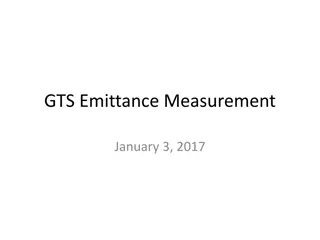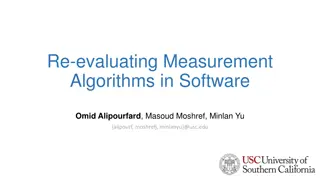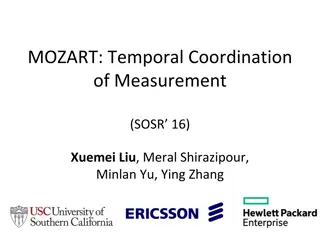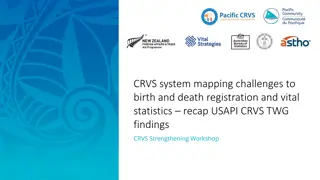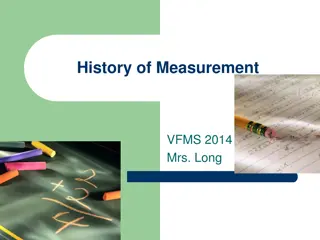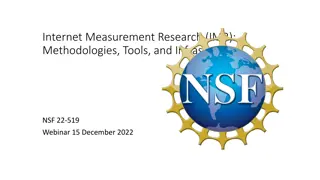Enhancing Economic Measurement Priorities
This presentation discusses the priorities and plans for extending national accounts, emphasizing the incorporation of human capital investment and welfare measurement. Short-term goals include integrating human capital investment into regular reporting, while long-term goals focus on measuring welfare beyond GDP. Key methodologies and challenges in these areas are highlighted, drawing on research by prominent economists.
Uploaded on Mar 03, 2025 | 0 Views
Download Presentation

Please find below an Image/Link to download the presentation.
The content on the website is provided AS IS for your information and personal use only. It may not be sold, licensed, or shared on other websites without obtaining consent from the author.If you encounter any issues during the download, it is possible that the publisher has removed the file from their server.
You are allowed to download the files provided on this website for personal or commercial use, subject to the condition that they are used lawfully. All files are the property of their respective owners.
The content on the website is provided AS IS for your information and personal use only. It may not be sold, licensed, or shared on other websites without obtaining consent from the author.
E N D
Presentation Transcript
GDP AND BEYOND: PRIORITIES AND PLANS Discussant s Comments by Dale W. Jorgenson Presented to the Advisory Committee of the Bureau of Economic Analysis November 9, 2018
GDP AND BEYOND: PRIORITIES AND PLANS Steve has done an excellent job of laying out the issues involved in developing a plan to integrate, prioritize, and produce estimates that extend the national accounts. He has asked the Advisory Committee to list its top priorities for short-term and long-term programs. I agree with Steve s approach and will discuss in more detail my top short- term and long-term priorities. My top short-term priority is to incorporate investment in human capital into BEA s regular reporting as a satellite account. BEA has maintained a research program on investment in human capital. The latest report was published by Barbara Fraumeni, Michael Christian, and Jon Samuels in the December 2017 issue of the Review of Income and Wealth. My top long-term priority is the measurement of welfare. Although GDP is often used as a proxy for welfare, GDP is best viewed as a measure of production. Many different approaches to welfare measurement have been discussed in the research literature. I will discuss an approach that Daniel Slesnick and I have proposed that is integrated with the national accounts.
INVESTMENT IN HUMAN CAPITAL: Top Short-Term Priority Fraumeni, Christian, and Samuels (2017), have presented an approach to investment in human capital that is integrated with the U.S. National Income and Product Accounts. This employs the lifetime income approach to human capital measurement that Fraumeni and I originally introduced in our papers from 1989 and 1992. Investment in human capital is based on the same methodology as investment in physical capital. The methodology begins with the definition of income generated from human capital. This includes income from participation in the labor market and non- market income, including leisure time, household production, investment in education, and investment in child-rearing. Lifetime income for all individuals in the population is estimated by projecting the growth of income over the individual s lifetime and discounting this back to the present. This generates the asset value of lifetime income and the return from this asset includes both market and non-market returns in each time period.
INVESTMENT IN HUMAN CAPITAL: Top Short-Term Priority The figure shows a complete set of national accounts for the United States for the period 1950 to 1984 and 1989 to 2009. This is consistent with the U.S. national income and product accounts, but is expanded to include investment in human capital.
MEASUREMENT OF SOCIAL WELFARE: Top Long-Term Priority The first challenge in measuring social welfare is to overcome the long-time presumption of many economists that measuring welfare is impossible. This has given way to measures of poverty and inequality based on measures of individual and social welfare. Individual welfare is defined for households in terms of consumption per household equivalent member in real terms. Jorgenson and Schreyer, Review of Income and Wealth, December 2017 Issue, have shown how to incorporate information about the distribution of consumption into systems of national accounts. This is the first novel feature of social welfare measurement. Data on household consumption must be combined with the number of household equivalent members and the cost of living for each household to obtain a measure of household welfare.
MEASUREMENT OF SOCIAL WELFARE: Top Long-Term Priority The third and final step in the measurement of social welfare is to introduce a social welfare function to integrate the measures of individual welfare for all households. Jorgenson and Slesnick (2014) have proposed a class of social welfare functions consisting of the mean of measures of individual welfare and a generalized variance, consisting of deviations of measures of individual welfare from the mean. Jorgenson and Slesnick (2014) have presented utilitarian and egalitarian social welfare functions defined on measures of individual welfare.
CONTRIBUTIONS TO GROWTH IN THE US STANDARD OF LIVING, 1948-2010
SUMMARY AND CONCLUSION Steve Landefeld has demonstrated that the Bureau of Economic Analysis has generated a wide variety of different measures that would provide highly useful extensions of the core BEA product, the NIPAs. In this comment I have illustrated a promising short-term project that could produce regular estimates of investment in human capital as a satellite system of accounts. A useful measure of investment in human capital uses the same principles of measurement as investment in physical capital. This involves extending the national accounts to incorporate non-market income that is combined with market labor compensation to obtain a comprehensive measure of lifetime labor income that can be used to extend the national accounts.
SUMMARY AND CONCLUSION Second, I have considered a long-term project that builds on measures of individual and social welfare proposed in the research literature. The starting point for this project is measures of individual welfare based on household consumption. Consumption by individual households is combined by means of household equivalence scales and prices of the level of living to obtain measures of social welfare. The measurement of individual and social welfare can be carried out within the national accounts. However, this involves evaluation as well as data development. I have proposed a simple approach that captures the features that are already widely employed in the literature on the measurement of poverty and inequality.







